Aberdeen Suburban Tramways
History
The Aberdeen Suburban Tramways were a rather strange affair, effectively encouraged by Aberdeen Corporation as extensions to its own system, but financed and built by a private company — the Aberdeen Suburban Tramways Company — ostensibly because the corporation could not legally build lines outside the municipal boundary. The system consisted of two completely separate standard-gauge lines, one extending the corporation's Mannofield line southwestwards to Bieldside, and the other from the terminus of the corporation's Woodside line westwards to Bankhead; together, the two lines totalled a mere 4.59 miles.
The first services commenced on the 23rd June 1904 over the Bieldside line, followed on the 8th July by the Bankside line; through-running agreements were in place from the start, allowing ASTCo cars to run into central Aberdeen, thus avoiding the need for passengers to change cars at the municipal boundary.
Although the company suffered initially from being under-capitalised, the lines built being foreshortened versions of the those originally envisioned, it actually turned out to be moderately successful financially. It was however heavily dependent upon the corporation, both for the power supply and through running into the city centre, a situation which was ultimately to be its undoing. It also operated two geographically unconnected lines — both constructed on the single line and loop principle — and this inevitably led to problems with timekeeping, which had a knock-on effect on tramcar services within the city.
Arguments between the company and the corporation over power costs, through-running, poor punctuality, and even the pay of ASTCo staff, eventually led the corporation — in 1915 — to attempt to buy the company and incorporate the services into those of the ACT. Although the ASTCo were receptive, providing the price was right, the corporation-sponsored independent valuation came out considerably higher than the corporation had expected, so the whole thing was dropped.
Although the relatively high valuation, as well as the introduction of buses (in 1914), suggested that the company was in good shape, it was in fact on a downward spiral, which was greatly accelerated by the exigencies of the Great War. After the war, the poor condition of the track and vehicles, and the ASTCo's penchant for paying its staff as little as it could get away with, once again led to conflict with the corporation. The upshot of this was another corporation offer — by all accounts a generous one — to buy the company (in 1923), which the latter chose not to immediately accept, no doubt angling for more money. They had however completely misjudged the strength of their own position, as well as the determination of the corporation, the latter promptly walking away.
The ASTCo now found itself with a decrepit tramway exposed to the full force of unregulated bus competition. The company's answer was to focus on its bus operations and to run the trams down even further, the company's motorbuses being transferred to a separate entity — the Aberdeen Suburban Transport Company — in 1925.
By the following year, the tramway track and tramcars were in such a bad state that the corporation terminated through running, which was pretty much a fatal blow for a system that was already on its knees. Somehow, the tramway struggled on for another 12 months, almost to the day, with final closure probably taking place on the 9th June 1927 (the precise date seems not to have been recorded).
Uniforms
The ASTCo appears to have been rather tardy in issuing uniforms, with many staff simply wearing second-hand heavy overcoats (albeit with shirts and ties) and flat caps, well into 1906. This relaxed approach to uniforms eventually led to a letter of complaint from the corporation (in 1906), who felt that the company men were lowering the tone of the corporation lines over which they operated (thanks to Mike Mitchell for this information).
The first uniforms bore a striking resemblance to those issued by the corporation, very probably being obtained from the same supplier. They were navy blue with red piping, and were single-breasted with five buttons and lapels; the styles issued to conductors and motormen differed slightly, the former having two breast pockets (with button closures), and the latter two/three waist-level pockets. Neither type carried badges. The company also followed general corporation policy in respect of caps, with conductors wearing kepis, and motormen wearing tensioned-crown peaked caps; standard script-lettering badges were worn, either Conductor or Motorman. It is unclear whether the buttons and badges were in brass or nickel, though probably the former given the ASTCo's predilection for following corporation uniform policy, as the latter certainly used brass insignia on its tramcar-crew uniforms.
By the time of the Great War, the uniform jackets had been subtly altered; though still single breasted with lapels, they now bore four buttons and three pockets (two waist and one hip), and as before, were devoid of insignia. Caps for both conductors and motormen were now of the tensioned-crown peaked type, but with a distinctive wide crown; they continued to carry script-lettering cap badges, which towards the end of operation were of the underlined variety.
Inspectors wore single-breasted jackets with lapels; the latter were edged in a lighter material (possibly silver in colour) with the collars carrying Inspector in embroidered script lettering. The tensioned-crown peaked caps carried a hat band of a lighter colour (again probably edged in silver) that bore the grade — Inspector — in embroidered script lettering. Senior staff uniform buttons may have been nickel to match the silver edging.
As with many tramway operators, the ASTCo employed female staff during the Great War — both as conductresses and as motorwomen — to replace male staff lost to the armed forces. By the end of the war, all tramcar crews, bar four motormen, were women. The ladies were provided with long, tailored single-breasted jackets with four buttons and a waist belt (with button fastening), two waist and two breast pockets (with button fastenings) and lapels; the jackets do not appear to have carried any form of insignia. Headwear consisted of baggy caps with cloth-covered peaks, sometimes referred to as 'motor caps'; they bore standard script-lettering grade badges, Conductor or Motorman.
With grateful thanks to Mike Mitchell for sharing his photos and knowledge.
Further reading
For a history of the tramway, see: 'The Aberdeen Suburban Tramways' by M J Mitchell and I A Souter; N B Traction (1980).
Images
Motormen and conductors
A motorman and two conductors pose with Tramcar No 2 at Bankhead circa 1904/5. All three men are without uniforms or official caps.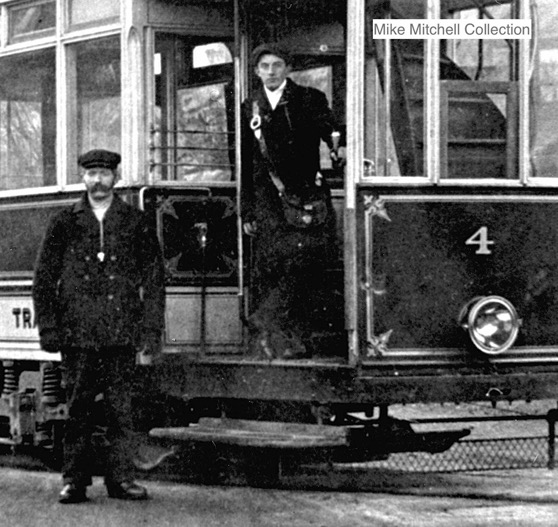
Another photo taken at Bankhead, circa 1904/5 — once again, the crew are without official uniforms.
A conductor and a motorman aboard the steps of Tramcar No 1 at Bankhead circa 1906. The photo was presumably taken after the corporation had made a request for the ASCTCo to smarten the appearance of its employees. 
An enlargement of the above photo that clearly shows the similarities in uniform practice, both jackets and caps, between the ASTCo and its neighbour, Aberdeen Corporation Tramways. The conductor is wearing a kepi-style cap with a script-lettering Conductor badge, the motorman a tensioned-crown peaked cap bearing a Motorman grade badge. Both jackets are single-breasted with lapels and two button-closed breast pockets. Other images clearly show that motormen, like their ACT counterparts, usually wore a jacket with waist-level pockets.
Standard ‘off the shelf’ script-lettering cap badges of the type used by the ASTCo — brass. On the balance of probability, the ASTCo buttons and insignia were probably brass. Author's Collection.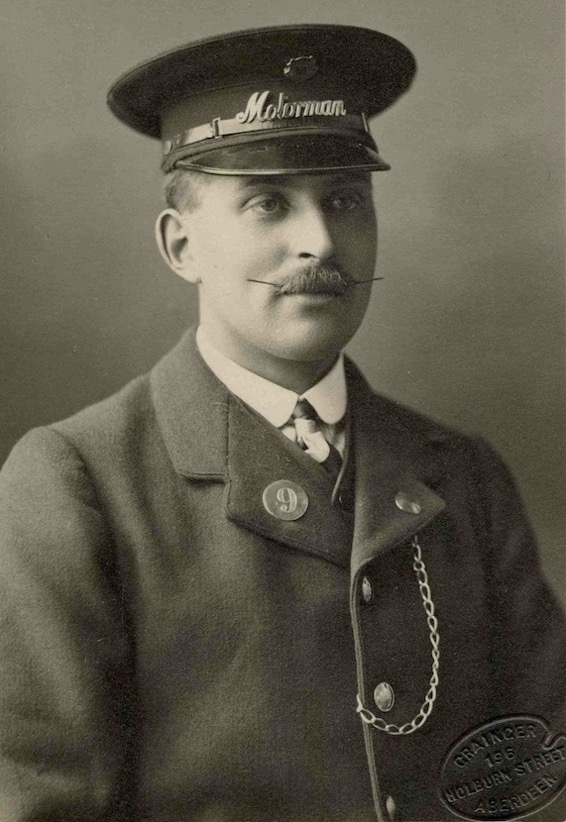
An Aberdeen motorman (No 9), almost certainly an employee of the ASTCo — photo undated, but very probably mid Edwardian. The cap badge is in the shape of the arms of Aberdeen, so may well have been a personal addition (ASTCo tramcars carried a similar shaped device on their waist panels). The metal number on his lapel is another mystery, as it is not seen in any other photos. Author's Collection.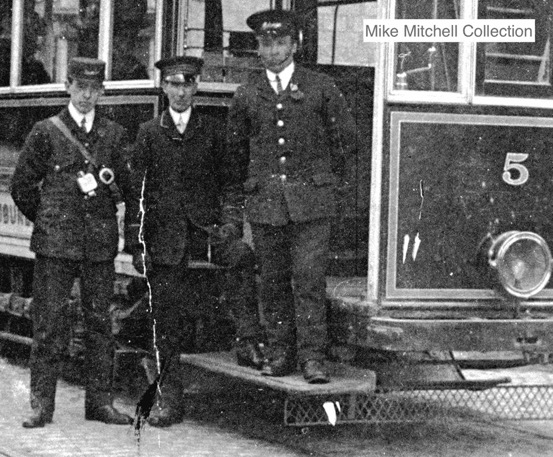
An unknown conductor, Inspector Kerr and Motorman George Cormack pose with Tramcar No 5 at Mannofield Depot circa 1906.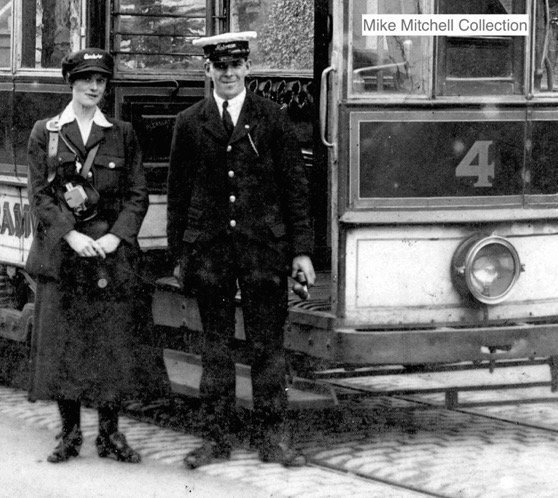
A conductress and a motorman with Tramcar No 4 at Bankside — photo undated, but certainly taken some time between 1915 and 1919.
An enlargement of the above photograph showing the motorman.
Another Great War shot, this time of Conductress Barbara Craib and Motorman George Skinner, with Tramcar No 8 at Mannofield Depot.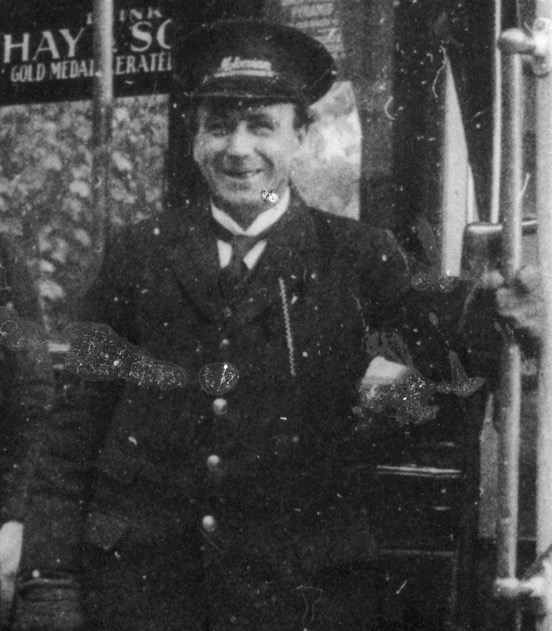
An enlargement of the above photo showing Motorman Skinner, who is wearing a rather natty wing-collared shirt.
An inspector, believed to be Mr Matthew, and a rather tense-looking motorman, pose with Tramcar No 6 at the Bankhead Terminus — photo undated, but probably taken in the 1920s.
An enlargement of the above photo showing the motorman. His jacket is completely devoid of insignia, whilst his cap carries an underlined, script-lettering grade badge, a style which was rarely used by tramway operators in the British Isles, but which was also used on the ACT during this period.
Senior staff
An enlargement of the circa 1906 photograph of Tram No 5 above showing Inspector Kerr. Although of poor quality, it does show that the jackets were single-breasted with lapels, and that the collars and hat band were edged in material of a lighter colour.
An enlargement of the 1920s photograph of Tramcar No 6 above showing the inspector, who is believed to be a Mr Matthew. The edging on the collars and the hat band is easily made out. He is wearing a round badge on his right lapel, which is more than likely a Great War Silver War Badge, signifying that the holder had been honourably discharged from the armed forces.
Female staff
An enlargement of the Great War photograph of Tramcar No 4 above showing the conductress. Her tailored jacket is devoid of insignia, whilst her baggy cloth cap bears a standard script-lettering Conductor badge.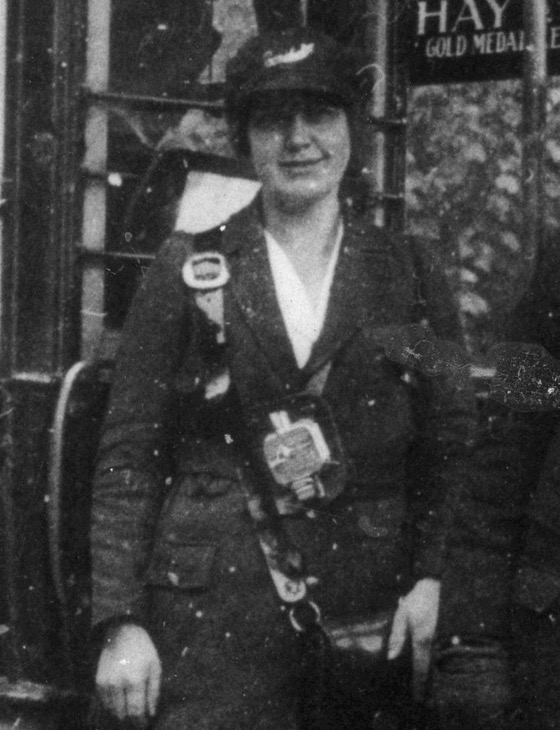
An enlargement of the Great War photograph of Tramcar No 8 above showing Conductress Barbara Craib. Miss Craib was the grand-daughter of Forbes Christie, the ASTCo Permanent Way Foreman; she worked for a short time on the trams in Lanark (they recruited female staff from the Aberdeen area), but returned home when the ASTCo started hiring female staff. See the Lanarkshire Tramways Company entry for a studio portrait of her in her LTCo days (link).
A conductress and a motorman with Tramcar No 7 at Bieldside — photo undated, but, certainly taken between 1915 and 1919.
The crew of Tramcar No 11 stand with their charge outside Bieldside Church — photo undated, but certainly taken during the Great War or shortly thereafter. With thanks to the National Tramway Museum. 
An enlargement of the above photo showing Motorman Webster, smartly turned out with white summer rain cover on his cap, and an unknown conductress.
A group of ASTCo staff with Tramcar No 4 at the Bankhead terminus during or shortly after the Great War. From left to right: an unknown motorman, Motorman Joe Ross, an unknown conductress, Motorman Forbes Robertson, an unknown conductor and Motorwoman Jean Robbie; Inspector Matthew stands behind them on the tramcar platform. With thanks to Mike Mitchell and First Aberdeen.